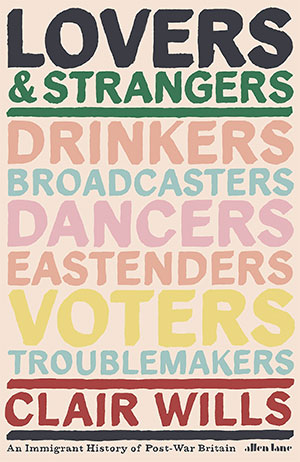Lovers and strangers: an immigrant history of post-war Britain
Published in Book Reviews, Book Reviews, Issue 4 (July/August 2018), Reviews, Volume 26CLAIRE WILLS
Allen Lane
€30
ISBN 9781846147166
Reviewed by Mary Kenny
Mary Kenny’s most recent book is Am I a feminist? Are you? (New Island).
 Everyone is familiar with the legend that Irish migrants to Britain were greeted with landlords’ notices saying ‘No blacks, no Irish, no dogs’. I have never quite believed this particular narrative, since it is rare indeed for the English to banish dogs. I daresay there were signs saying ‘No coloureds, no Irish’ back in the 1950s and ’60s, but adding ‘dogs’ is the implausible coda.
Everyone is familiar with the legend that Irish migrants to Britain were greeted with landlords’ notices saying ‘No blacks, no Irish, no dogs’. I have never quite believed this particular narrative, since it is rare indeed for the English to banish dogs. I daresay there were signs saying ‘No coloureds, no Irish’ back in the 1950s and ’60s, but adding ‘dogs’ is the implausible coda.
In this rewarding survey of immigration to post-1945 Britain, Clair Wills examines some of the evidence of rejected accommodation: many an Afro-Caribbean, like the academic Stuart Hall, was simply told ‘We don’t take blacks’, and Italians settling in Wales were disparaged by the locals for having ‘too much sex appeal’ (I’ll bet!). In North Kensington in 1958, one accommodation notice in eight specified discrimination (‘No Coloured’, ‘Europeans Only’, ‘White People Only’, ‘English Only’), while a small portion specified ‘all nationalities’ and a few said ‘coloureds only’. A year later, such notices had increased to one in six, with landlords saying that ‘the other tenants wouldn’t like it’ if Indians or West Indians were accepted. And then there was another gradation of exact skin tone. Distinctions were made between the ‘jet-black’ and the ‘coffee-coloured’.
I might add that older Australians have told me that the Earl’s Court area had signs saying ‘No Australians’, since they had a boozy reputation—but that’s perhaps a distinction between behaviour and ethnicity.
Clair Wills, an academic teaching at Princeton whose mother is Irish (a tender last chapter brings a personal insight here), illuminates the problems and difficulties that migrants—who then become immigrants—experience in a host society, and some of the problems that a host society experiences too. Some of the aspects are sad: migrants from rural Ireland, though they had more ease of travel and access than many others, felt the break with home life profoundly. Some are interesting and quirky: West Indians arriving in what they had been taught to call ‘the Motherland’ were astonished to see white people doing menial jobs. They thought that ‘all white people spoke like Prince Charles and were in very high positions’.
In the post-1945 world, Europe was piteously full of displaced persons. In Germany alone there were seven million refugees; there was a Polish diaspora of five million after the dislocation of war and the somewhat arbitrary redrawing of frontiers. Very many wanted to come to Britain, not always to a rapturous welcome; even left-wing media weren’t always sympathetic. In 1948 the Daily Mirror wrote that ‘In taking Displaced Persons wholesale we have had a bad deal. Too many are living or working in some dubious way … they live on our rations … They add to our discomfort and swell the crime wave.’ The establishment of the welfare state had heightened, rather than diminished, the sense of Britishness as opposed to ‘others’: ‘we’ had paid into the system, while ‘they’ were incomers benefiting from it.
Grumbles about Irishwomen also occurred: a social worker and a medical pathologist wrote to The Times in 1962 that ‘there is a considerable minority of stupid, self-neglectful unmarried Irish girls who appear to come to England to obtain maternity care and to have the baby adopted’.
There were hard times for Irish migrants, for sure, and yet the British–Irish relationship was so economically intertwined that a common interest drove a degree of integration. The British needed labour and the Irish needed work. Irish nurses were at first suspected of being under-educated (middle-class Irish nurses tended to get jobs in Ireland, whereas poorer young women emigrated), but they soon won hearts and minds in the expanding NHS, and by the mid-1950s they were highly valued, even favoured.
The Irish themselves were not free from prejudices. The ‘Irish and Poles’ were among the most vehement in objecting to ‘black guys dancing with white girls’. If I may make a culturally based generalisation, the black guys were probably better dancers!
As time went on, things improved and yet, when it came to race relations, sometimes they became more adversarial. There was gradually more integration—but there were race riots in the 1960s, and after Enoch Powell made his toxic speech about ‘rivers of blood’ in 1968 it became impossible to discuss immigration in the public realm for the next 40 years. Absorbing different cultures into a host community takes time, thought, sensitivity, leadership, honesty and common sense, and not talking about it helps no one.
There are many fascinating nuggets: Brendan Behan was suspected of being a Communist by MI5, but eventually the intelligence agency decided that he was too unreliable to be an effective one. De Valera considered banning adverts luring Irish migrants to England, when it is obvious that it was Dev’s lamentable failure to modernise the Irish economy in the 1950s, as Seán Lemass knew, which caused much of the emigration haemorrhage.
And it’s riveting to learn that the reluctance of women—especially married women—to join the British workforce in 1945 was what pushed the economic demand for migrant labour. The government begged women to fill the jobs after the war, but no, they weren’t having it. They wanted a period of domestic peace after the rigours of wartime work, and so the boats set sail from the sub-Indian continent and the Caribbean islands—and Dún Laoghaire—to fill job vacancies in that post-war Britain.
















